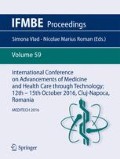Abstract
Identification of animal species by their sounds is important for biological research and biodiversity assessment. In this paper we investigate the use of a dedicated TESPAR analysis, which does not use directly the acoustic signal from animals, but cepstral coefficients derived from it (MFCC and T-MFCC), to discriminate between different species. Our experiments shows that TESPAR S-matrices of some cepstral coefficients can be successfully used to discriminate between different animal species.
Access this chapter
Tax calculation will be finalised at checkout
Purchases are for personal use only
Preview
Unable to display preview. Download preview PDF.
References
Chang-Hsing Lee, Yeuan-Kuen Lee, Ren-Zhuang Huang (2006), Automatic Recognition of Bird Songs Using Cepstral Coefficients, Journal of Information Technology and Applications Vol. 1 No. 1, May, 2006, pp.17-23.
Deshmukh O., Rajput N., Singh Y., Lathwal S. (2012), Vocalization patterns of dairy animals to detect animal state. 21st Int. Conf. Pattern Recognition (ICPR 2012) November 11-15, 2012. Tsukuba, Japan.
E. D. Chesmore (2004). Automated bioacoustic identification of species. An. Acad. Bras. Ciênc. 76(2): 435 – 440.
Huang, X., Acero, A., Hon, H. (2001), Spoken Language Processing. Prentice Hall.
H.A. Patil, T. K. Basu (2008), Identifying perceptually similar languages using teager energy based cepstrum. Engineering Letters, 16(1):151–159.
P. Maragos, J. F. Kaiser, and T. F. Quatieri (1993), Energy separation in signal modulations with application to speech analysis. IEEE Trans. Signal Processing 41, 3024.
R.A. King, T.C. Phipps (1998), Shannon, TESPAR And Approximation Strategies. ICSPAT 98, Vol. 2, pp. 1204-1212, Toronto, Canada, Sept. 1998.
E. Lupu, S. Emerich, F. Beaufort (2009), On-line signature recognition using a global features fusion approach, Acta Tehnica Napocensis, Electronics and Telecomunications, Vol.50, no.3, pp. 13-20, 2009.
Author information
Authors and Affiliations
Corresponding author
Editor information
Editors and Affiliations
Rights and permissions
Copyright information
© 2017 Springer International Publishing AG
About this paper
Cite this paper
Pop, G.P. (2017). Discriminate Animal Sounds Using TESPAR Analysis. In: Vlad, S., Roman, N. (eds) International Conference on Advancements of Medicine and Health Care through Technology; 12th - 15th October 2016, Cluj-Napoca, Romania. IFMBE Proceedings, vol 59. Springer, Cham. https://doi.org/10.1007/978-3-319-52875-5_41
Download citation
DOI: https://doi.org/10.1007/978-3-319-52875-5_41
Published:
Publisher Name: Springer, Cham
Print ISBN: 978-3-319-52874-8
Online ISBN: 978-3-319-52875-5
eBook Packages: EngineeringEngineering (R0)

